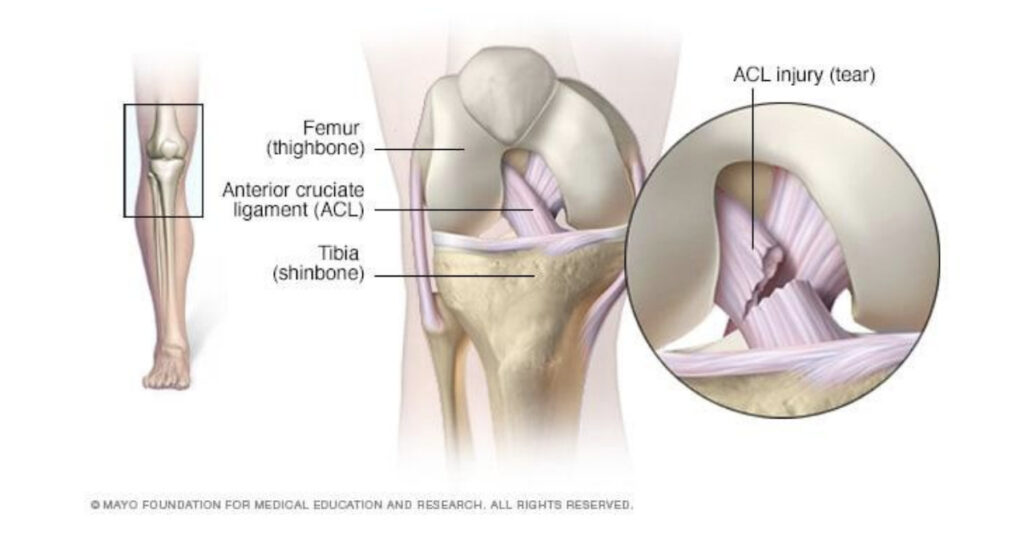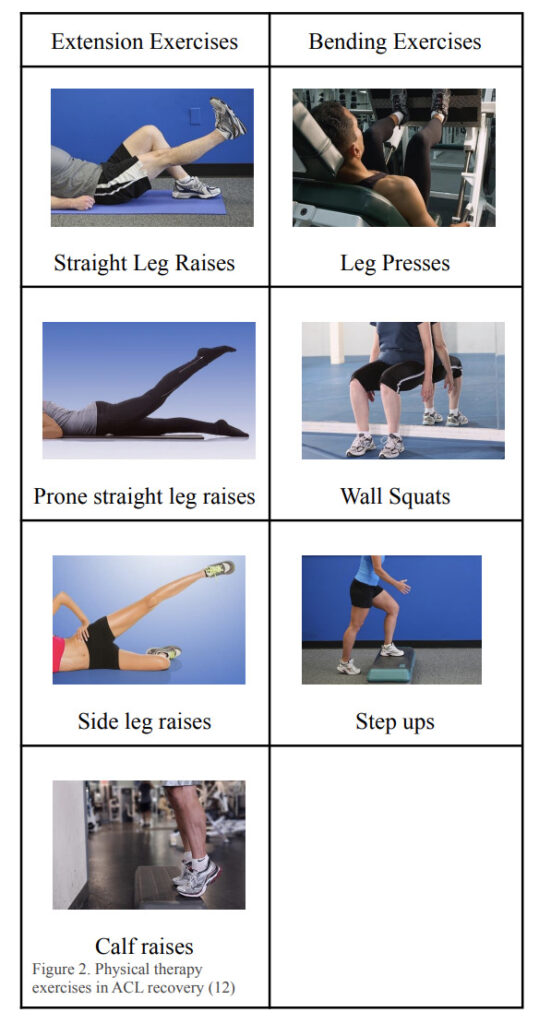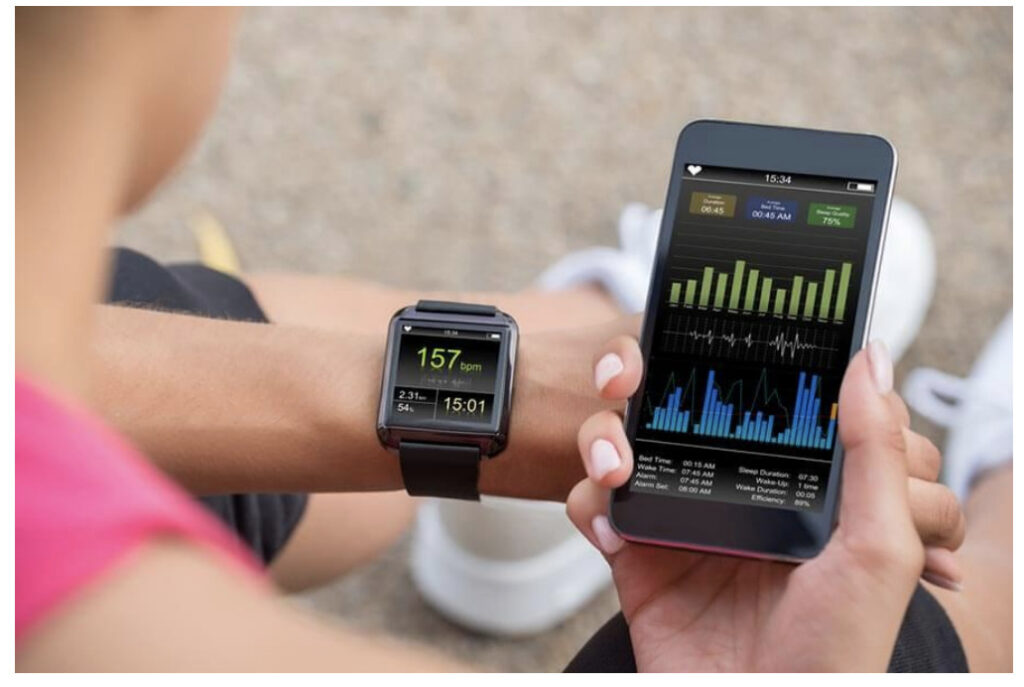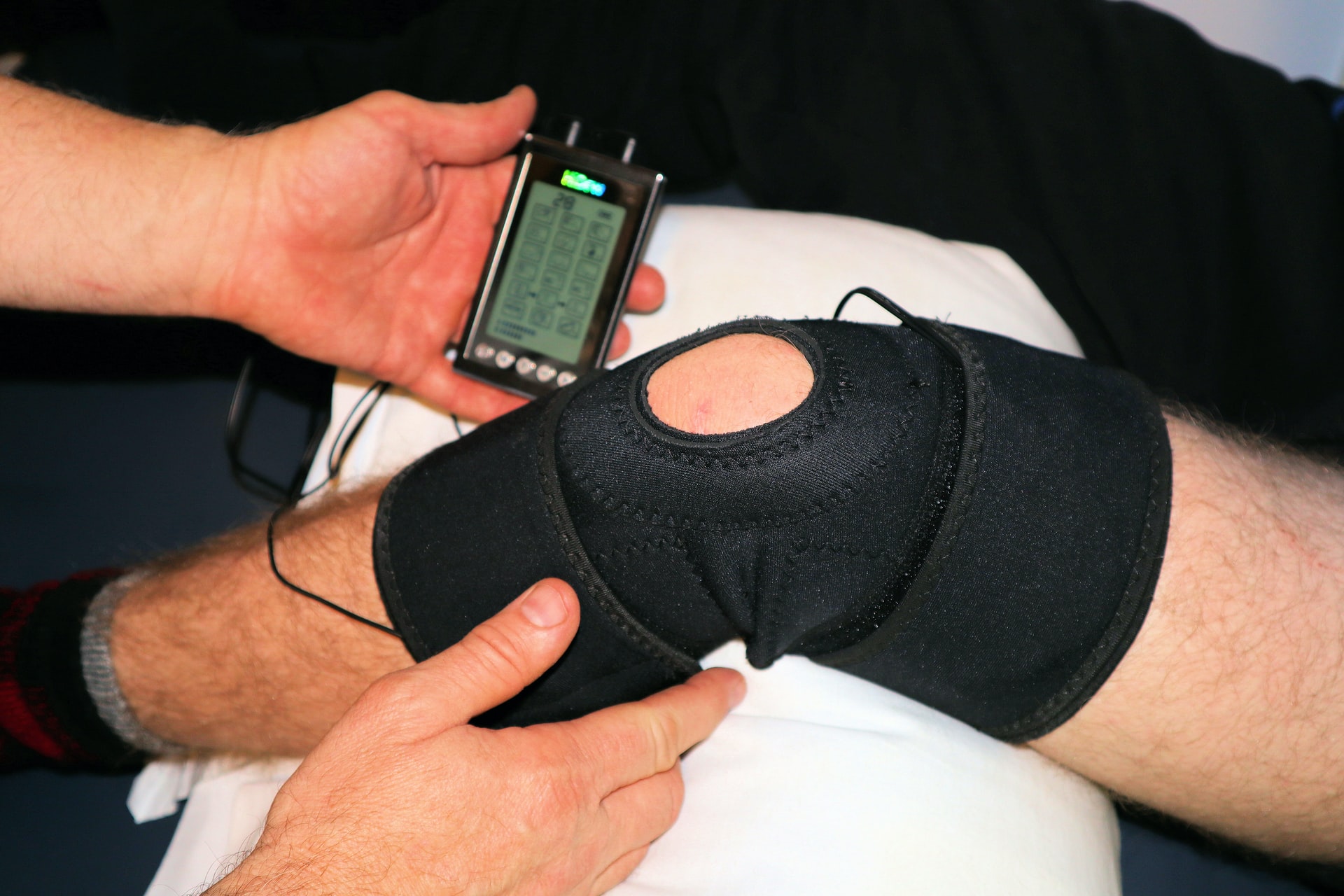
Author:Daniel Gassenheimer
Jericho High School
September 1, 2021
Abstract
There are 100,000-200,000 anterior cruciate ligament (ACL) injuries in the United States each year. Physical therapy is a crucial process in the recovery from the ACL reconstruction surgery, involving physical exercises for patients to recover faster. Mentality of the patients plays an important role as well in this process. Besides conventional physical therapy exercises, there is a range of new technological approaches available to facilitate the recovery. The purpose of this paper is to review current options in physical therapy as well as technological advances. Novel technologies like wearable devices and virtual reality physical therapy are discussed.
Introduction
One wrong step. This is all it takes for the anterior cruciate ligament (ACL), one of the most common places of injury to the knee, to tear. There are commonly between 100,000-200,000 ACL ruptures in the United States every year (1). This ligament runs diagonally through the center of the knee, and provides support for the joints involved, shown in figure 1(2). This is commonly injured due to a pivot or improper jump landing, generally seen in
contact sports (3). “Many people hear a pop or feel a “popping” sensation in the knee when an ACL injury occurs. Your knee may swell, feel unstable and become too painful to bear weight (4).” Although this injury has different levels of severity and treatment required, surgery is usually a first step on the road map (5). Whether using an autograph, (graph taken from muscle or ligament in patients body) or a cadaver (donation from a deceased body), reconstruction surgery involves forming a new ACL through implemented stretched muscle, which is then secured into the body (6).

After one receives surgery, the extensive rehabilitation process begins, commonly known as the most important part of a recovery. Physical therapy is typically used to support the recovery, and help improve the patient’s outcome. Due to the wave of new technology over the last few decades, many new tools are available combining engineering and technology to injury recovery. In this review paper, we are discussing the commonly used physical therapy process after ACL surgery, as well as technology that is being designed to help facilitate it. This paper is inspired by the personal recovery of the author.
Conventional Physical Therapy
Physical therapy in an ACL tear is marked through a six month (average 22 weeks) therapy that is broken up into checkpoints about what a patient is able to perform (7). For the first phase of recovery, which usually consists of the first two weeks to a month, the main focus of the recovery process is to reduce the swelling and regain knee extension; painkillers, physical therapy and icing sessions become priority during the first month phase (7). The common exercises for this initial period after surgery focus on improving knee extension and reducing stiffness, with a focus on bending and straightening the knee (8). This generally includes straight leg raises, towels under the knee and ankle, and practice bending the knee to a 90 degree angle, as shown in Figure 2 (9). The patient will find these activities will become less difficult with more practice and time icing the knee to reduce swelling (9). From the interview between the author of this paper and Physical Therapist Victoria Wilson, the ability to fully extend the knee is one of the most important parts of recovery, since it allows for optimal hamstring and quadricep strength, and reduces risk of retear, which already has a high rate of 24% (10). Also, it is very important to work on full knee extension early on, because if not, scar tissue begins to build up, which will require additional surgery and physical therapy, as well as starting a more excruciating recovery process from scratch.
In addition to the physical recovery process, mentality plays a huge part in achieving full success. According to Wilson, many of her ACL patients don’t return to their contact sports due any fear of retear. According to Lorenz Buchler, from the department of Orthopaedic Surgery in the University of Bern, Switzerland, only about ⅓ of patients return to their sport after a year post surgery, and 50% in 2-7 years (11). This is due to all of the trauma that comes with an intense recovery process. In order to overcome that fear, the patients need to keep performing physical therapy, completing the exercises, and maintain a positive and patient mindset in that process. In the initial recovery process, the exercises completed allow for crucial knee extension and flexibility. A variety of exercises intended to strengthen the knee in this regard is described throughout the diagrams below (12). It is very important for the patient to complete these exercises on a regular basis, in order to prevent physical setbacks such as extra surgery and mental setbacks such as longer recovery time. As with any injury of this sort, physical therapy is the most crucial part.

New Technology Applications in ACL Recovery
In the modern world, there are many solutions involving technology to advance recovery from an advanced surgery such as ACL reconstruction (13). Wearable technology, virtual reality (VR), and telerehabilitation are all used in different ways to make the recovery process easier.
For example, wearable tech, such as watches and bracelets, are used to detect range of motion (14). This technology is used to collect data about movement patterns, and issues with the exercises to detect if there are any problems with the recovery (14). For example, technology such as DorsaVi provides medical professionals and athletes real time data about one’s injury recovery, which uses wireless sensors placed on the legs and lower back during times of exercises, that can measure the twists, turns, bends, speed and even the G-Force of the exercises (15). This is possible using tiny accelerometers, magnetometers and gyroscopes in the sensors that help collect the data from the body (15). This information can be used, alongside patient questionnaires, to give a more accurate representation on how a patient’s recovery is progressing.

In addition, a virtual system for physical therapy, including virtual reality, after knee injuries has been experimented with (16). One of the VR programs is called “VERA,” which is a platform that brings the guidance of a physical therapist into the home along with tools that help clinicians remotely monitor patient progress beyond the traditional in-clinic setting (17).Typically, the VR is used with a series of games that include different purposes, such as increasing muscle strength and improving bodily balance (10). For example, a body balance weight can be moved from one leg to the other, coordinating to something occurring on a VR screen. In a study by Wolters Kluwer Health, which contained 306 patients with the average age of 65, 88% of participants in virtual physical therapy completed their exercises, compared to only 65% during in person physical therapy (18). In addition, returning to normalcy rates remain similar between both options. However, the rates of reinjury increase for the virtual options (18).
Besides this example, other studies used telerehabilitation, in which rehabilitation service is provided through telecommunication (internet), to compare pain rates, return to normalcy, rates of reinjury, and motivation in order to measure success of rehabilitation (19). Tests have been done in the past to compare normal knee physical therapy to balneotherapy (aquatic therapy), demonstrating positive and negative effects (20). Similarly, according to a study by the Yale School of Medicine, physical therapy with use of telerehabilitation improves resource saving, access to care, and learning and engagement (19).
Virtual physical therapy and telerehabilitation would be an option that would greatly benefit those who have trouble leaving their home, whether due to global or personal circumstances, as returns to strength and ability to accomplish tasks on one’s own are major improvements. However, with virtual and telerehabilitation physical therapy, the inability to have a personal physical therapist might cause detriment to the patient, as there is less access to manual therapy and opportunities to ask questions (10).
Conclusion
Besides conventional physical therapy, new technologies are being adopted into the world of rehabilitation from ACL, as well as other knee injuries. Wearable devices offer improved statistics and data for doctors to see in real time as the patients complete the exercises. Virtual reality and telerehabilitation allow for patients to complete physical therapy through them internet and technology, enabling a more successful recovery process. However, challenges with the implementation of these technologies still exist, and there are still many benefits to the conventional practice.
References
- Friedberg, R. P., Felds, K. B., & Grayzel, J. (2021). Anterior cruciate ligament injury. UpToDate. https://www.uptodate.com/contents/anterior-cruciate-ligament-injury#:~:text=EPIDEMIOLOGY%20%E2%80%94%20The%20ACL%20is%20the,2%2C7%2D9%5D
- Fletcher, J., & Morrison, W. (n.d.). Ten common knee injuries and treatment. Medical News Today. https://www.medicalnewstoday.com/articles/319324#ten-common-knee-injuriesinitial research on knee injuries
- Rothman Orthopaedic Institute. (n.d.). FAQs About Recovery From ACLSurgery. Roman Orthopedics.https://rothmanortho.com/stories/blog/faqs-about-recovery-from-acl-surgeryFAQs
- Mayo Clinic. (n.d.). ACL injury [Factsheet]. Mayo Clinic. Retrieved August 7, 2021, from https://www.mayoclinic.org/diseases-conditions/acl-injury/symptoms-causes/syc-20350738
- Heiden Orthopedics. (2020, February 24). What you should (and shouldn’t) do after ACL and MCL tears and surgery. Heiden Orthopedics. Retrieved August 7, 2021, from https://heidenortho.com/acl-mcl-tears-surgery/gave good dos and don’ts after surgery- maybe a posture checker for keeping the knee straight?
- Emory Healthcare. (2019). Rehab Timeline Expectations [Fact sheet]. ACL rehabilitation program. Retrieved August 7, 2021, from https://www.emoryhealthcare.org/centers-programs/acl-program/recovery/rehabtimeline.html Good timeline of recovery
- Dr. Alford. (n.d.). Dr. Alford’s postop instructions: ACL reconstruction [Pamphlet]. https://orthopedicsri.com/wp-content/uploads/2017/01/Alford-Postop-ACL-reconstruction.pdf Instructions for after surgery
- Murray-Weir, M., Levinson, M., Graziano, S., Horovitz, L., Galway, W., Fives, G., & Urmey, W. (2001). Your pathway to recovery: surgery for ACL injuries [Pamphlet]. Hospital for Special Surgery 535 East 70th Street, New York, NY 10021. https://www.hss.edu/Cordasco/ACL-Pathway-to-Recovery.pdfInformation about pt
- Caetano, D., Oliveira, C., Correia, C., Barbosa, P., Carvalho, P., & Montes, A. (n.d.). Physical Therapy in Sport. Science Direct, 129-137. https://doi.org/10.1016/j.ptsp.2021.01.015
- Büchler, L., Regli, D., Evangelopoulos, D. S., Bieri, K., Ahmad, S. S., Krismer, A., Muller, T., & Kohl, S. (2016). The Knee. Science Directb, 549-553. http://dx.doi.org/10.1016/j.knee.2016.01.012
- When an Injury Causes Knee Pain Knee Exercises. (2020, December 1). WebMD. Retrieved September 4, 2021, from https://www.webmd.com/pain-management/knee-pain/injury-knee-pain-16/slideshow-knee-exercised Used for pictures of physical therapy.
- MRegen’s Breakthrough Technology for Rapid ACL Recovery. (2019, January 24). The Healthcare Technology Report. Retrieved September 4, 2021, from https://thehealthcaretechnologyreport.com/mregens-breakthrough technology-for-rapid-acl-recovery/ Tech that heals the acl faster
- Newton, J. (2019, September 18). Is Wearable Tech the Future for Patient Recovery? The Yorkshire Knee Clinic. Retrieved September 4, 2021, from https://yorkshirekneeclinic.com/is-wearable-tech-the-future-for-patient-recovery/ First Source on wearable tech
- Adams, K. (2018, June 22). New technology used by the NFL is changing the game for Kentucky athletes. Courier Journal. https://www.courier-journal.com/story/life/wellness/fitness/2018/06/22/wearable-sensor-technology-changing-game-kentucky-athletes/620380002/ Sensor tech helping recovery
- Byra, J., & Czernicki, K. (2020). The Effectiveness of Virtual Reality Rehabilitation in Patients with Knee and
Hip Osteoarthritis. Journal of Clinical Medicine, 9(8), 2639. doi:10.3390/jcm9082639 More about vr - Hofheinz, E. (2018, March 14). Virtual Exercise Avatar Latest Rehabilitation Innovation. Rhy Orthopedics. Retrieved September 4, 2021, from https://ryortho.com/breaking/virtual-exercise-avatar-latest-rehabilitation-innovation/ Vera
- Caetano, D., Oliveira, C., Correia, C., Barbosa, P., Carvalho, P., & Montes, A. (n.d.). Physical Therapy in Sport.Science Direct, 129-137. https://doi.org/10.1016/j.ptsp.2021.01.015
- Hughes, C. (2020, January 16). Virtual physical therapy after knee replacement brings similar outcomes, lower costs. Eurekalert! https://www.eurekalert.org/news-releases/834276
- Gardner, E., & Dunphy, E. (2020). Telerehabilitation to Address the Rehabilitation Gap in Anterior Cruciate Ligament Care: Survey of Patients. JMIR, (e19296). https://doi.org/10.2196/19296 Telerehabilitation
- Peultier-Celli, L., Mainard, D., Wein, F., Paris, N., Boisseau, P., Ferry, A., Gueguen, R., Chary-Valckenaere, I., Paysant, J., & Perrin, P. (2017). Comparison of an Innovative Rehabilitation, Combining Reduced Conventional Rehabilitation with Balneotherapy, and a Conventional Rehabilitation after Anterior Cruciate Ligament Reconstruction in Athletes. Frontiers in surgery, 4, 61. https://doi.org/10.3389/fsurg.2017.00061Balneotherapy
About the author

Daniel Gassenheimer
Daniel is currently a senior at Jericho High School. He is an aspiring engineer, and greatly enjoys building and design challenges. He is a cross country/ varsity track runner. Unfortunately, he torn his ACL playing football with his friends, thus his inspiration for deep research into the subject and the creation of this paper.
